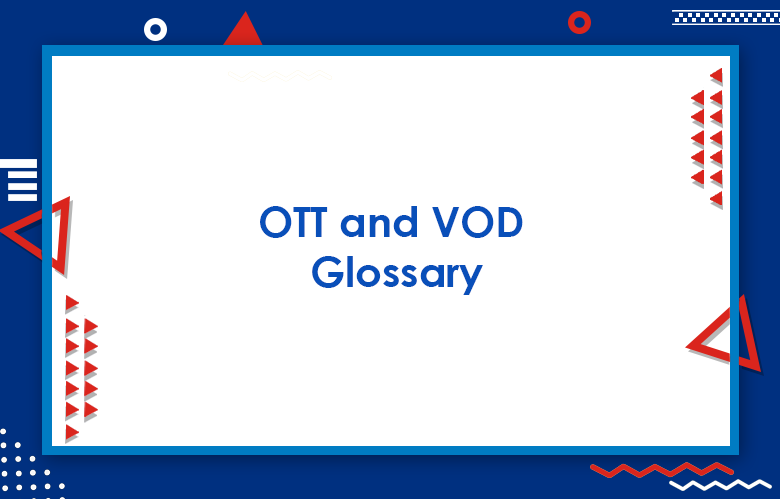OTT and VOD Glossary : 100+ Video On Demand (VOD) & Definitions You Need to Know

OTT and VOD Glossary Welcome to the era of OTT video streaming, where advertisers are confused about choosing the best engaging OTT and VOD platforms.
OTT video platforms distribute both linear and non-linear video-on-demand content. OTT and VOD enable the audience to watch video content when they want. They do not require the scheduling of TV programs, and the audience can schedule the programs when they want.
OTT and Video-on-demand services can be accessed on multiple devices. The top players are BBC iPlayer, Netflix, Hulu, YouTube, etc.
Both are delivered over the Internet, either free or paid. OTT is a subset of the VOD category, and OTT service providers completely replace traditional cable services.
Over-the-top, or OTT, is hot, with a market forecast to double to $12 billion by 2022. OTT is changing not only the shape of the marketing landscape but also how consumers buy content and media.
OTT and video-on-demand are two trending topics in the online video industry. This post provides a breakdown of each technology and offers a simple definition. It discusses the markets each technology can support and clarifies when OTT and VOD are interchangeable terms.
Over-the-top (OTT) refers to streamed entertainment content delivered from the cloud instead of a traditional broadcasting network. More simply, it’s all video-on-demand services. Examples include Apple TV, Hulu Plus, Netflix, and Amazon Instant Video.
You might have heard about over-the-top (OTT) services, which are disrupting the TV + Cable business model. On the upside, this disruption opens up some cross-industry players in streaming video and entertainment.
Industry giants like Google, Apple, Amazon, and Netflix are moving into this space, each with their own strategy. This post will explore OTT and the Online Video Ecosystem and shed some light on what this OTT thing is all about. It also aims to provide insights into what different strategies to execute and some possible outcomes.
OTT (over-the-top) is not a new concept, but it’s a growing means consumers use to stream video content. The emergence of “cord-cutters” and “cord-nevers” has added more fuel to the fire. OTT technology alters the expectation of what content should be delivered at a specific time. Businesses are struggling to adjust their strategies and services to an impatient audience.
To experiment with OTT and VOD platforms, business brands must be familiar with the significant terms and OTT and VOD glossary.
OTT and VOD Glossary: 100+ Video On Demand (VOD) & Definitions
360 Video Ads
4K
Academy eLearning Model
Ad Pod
Adaptive Bitrate Streaming (ABS)
Ad-based Video-On-Demand (AVOD)
Addressability
Addressable TV
Advanced TV
Amazon Fire TV
API
Apple TV
Audible and Viewable on Complete (AVOC )
Augmented Reality (AR)
Automated Content Recognition (ACR)
Autoplay Video Ad
AVOID
AVOD – Ad-supported Video On Demand
Bitrate
Bitrate or Bit Rate
Branded Video Content
CDN
Channel
Chromecast
Closed Captioning
Cloud Video Distribution
CMS
Connected TV (CTV)
Content Delivery Network (CDN)
Content Distribution Network CDN)
Cost Per Completed View (CPCV)
Cost Per Point (CPP)
Cost Per View (CPV)
Cost Per Viewable Impression (CPVI or VCPM/VCPV)
Cross-Screen Measurement
D2C or DTC – Direct To Consumer
Data-Driven Linear TV
Digital Rights Management
Dynamic Ad Insertion (DAI)
Dynamic Creative
eLearning
Electronic Sell-Through
Encoding
Encoding/ Transcoding/ Renditions
Endpoint
FAST – Linear Free Ad-supported Streaming TV
Genre-Specific SVOD – Genre-Specific Subscription Video On Demand
Gross Rating Point (GRP)
HD
HLS
HTTP Live Streaming
An identifier for Advertising on OTT
Ingest
In-Stream Video Ad
Intelligent OTT
Interactive Video
Interstitial Video Ad
IPTV
iPod
Keyframe
Latency
Live Streaming Video
Long-Form Video
Media Player
mLearning
Monthly Recurring Revenue
Multichannel Network (MCN)
Multichannel Video Programming Distributor (MVPD)
MVPD – Multichannel Video Programming Distributor
Native Advertising
Night School eLearning
OBS
OBS Settings
Online Academy
Online Course
Online Video Business
Online Video Platform
Online Video Subscription Business
Opt-In Value-Exchange Ads (aka rewarded ads)
OTT
OTT Infrastructure
OTT Streaming Platform
OTT Streaming Service
OTT Video App
Outstream Video Ad
Over-the-Top Device (OTT)
Over-the-Top Streaming Video (OTT Streaming Video)
Packet Loss
PlayStation
Pure-Play vMVPDs – Pure-Play Virtual Multichannel Video Programming Distributor
Quartiles
Real-Time Messaging Protocol (RTMP)
Resolution
Return path data (RPD)
Roku
RTMP
Server-Side Ad Insertion (SSAI)
Set-top box
Short-Form Video
Skippable Video Ad
Smart TV
Smart TV Platform
Software Development Kit (SDK)
Sticky Video Ad (aka adhesion ad)
Stream Key
Streaming
Streaming On-Demand
Subscription Business Model
Subscription Video-On-Demand (SVOD)
Subtitles
SVOD
SVOD – Subscription Video On Demand
Target Rating Point (TRP)
Teasers
Trailers
Transcode
Translate
TV Everywhere
AVOID
tvOS
User-Generated Content (UGC)
Vertical Video Ads
Video Ad Completion
Video Ad Completion Rate (VCR)
Video Ad Serving Template (VAST)
Video Aspect Ratio
Video Hosting
Video level data
Video Monetization
Video Multiple Ad Playlist (VMAP)
Video On Demand (VOD)
Video Player-Ad Interface Definition (VPAID)
Video Subscription Service Platform
Viewability Rate
Viewable Video Impression
Virtual MVPD (vMVPD)
Virtual Reality (VR)
VMVPD
vMVPD – Virtual Multichannel Video Programming Distributor
VOD
VTT Caption Format
Xbox
Advantages of OTT and Video-on-demand
Streaming makes people feel at home.
Streaming leads to fewer advertisements and better entertainment choices
Video-on-demand has become more affordable
Video-on-demand contains ads that users can click on
It is flexible and convenient
It allows freedom to range the programming to cater to viewers’ preferences.
It enables broadcasters and cable providers to create a business niche for themselves.
Content is uncensored
Allows for niche programming
Prices are lower and flexible
On-demand viewing is more convenient for subscribers
Provides competition for cable providers
Watch the video on TV, tablet, or computer
Pay per view
Video download service
On-demand download
Higher revenues per customer
More efficient management of cost
Better customized content to market needs
Expertise to sell niche products more efficiently
More investment in exclusive content
Cheaper than cable
Access to more TV shows & channels
The seamless on-demand viewing experience
Do away with internet cables and TV sets
Avoid monthly service charges
Watch what you want when you want
Low cost
No recurring payments
OTT content is future-proof
The devices are less expensive
TV channels are made into Apps
It is more flexible than a cable
Broadcasters can charge for individual programs
It boosts live sports coverage
Viewer analytics enables better decisions to be made regarding content scheduling and remuneration.
Reduction in costs
Major companies have already developed apps for it
Users have the option of on-demand and live viewing
Consumers can watch whatever they want to watch whenever they want
To be reached on the go
To protect what you want to watch
To have free time where no cable is accessible or Wi-Fi is poor
To avoid security issues
Pay per view
Cable cutting
More viewing options
Original content
Subscription-based model
The content is produced and distributed by the service provider
There is more control over the cost of content
There are no limitations in terms of platform or device used
Users will not have to subscribe to multiple services
Saving money
Play content anywhere and anytime
Save on data and storage
Takeaways:
Streaming Video-on-demand is a different way of viewing films
Use this information to enable a targeted message to be shown at the right time on the right platform
OTT (over-the-top) content is here to stay; it’s growing.
This could become another valuable revenue stream if you think outside the box.
OTT can be just the thing to help your content stand out and attract more viewers.
Video-on-demand and OTT content are the ways of the future, so embrace it!
If you are a content provider, you must learn how to be an OTT and VOD provider.
Today’s most successful businesses leverage on-demand video to reach their customers.
Conclusion:
Different OTT and VOD platforms have varied types of structures. To make your ad campaigns, you must know which terms are critical factors in engaging the audience. For example, Vimeo provides an article about the Vimeo OTT terms dictionary.
Call: +91 9848321284
Email: [email protected]



